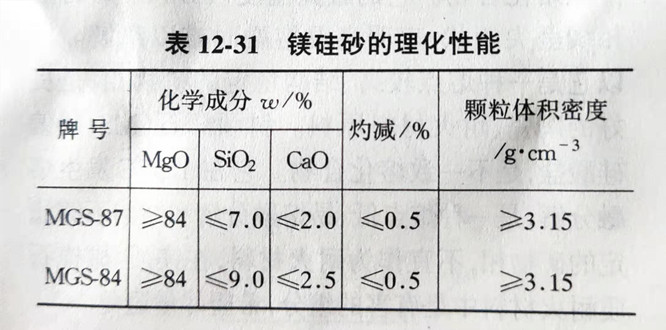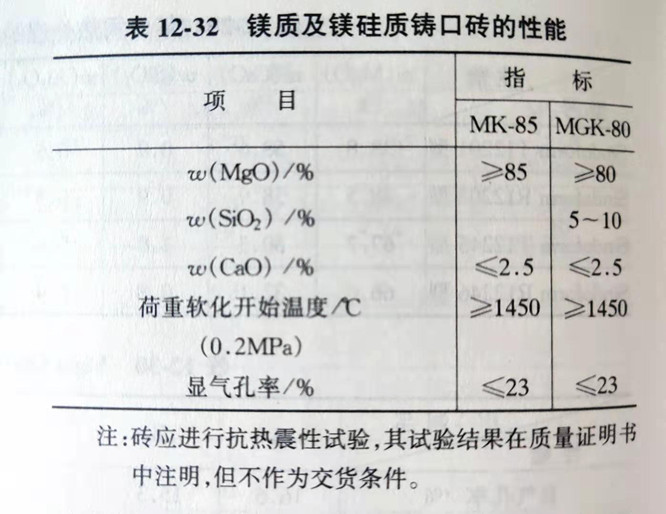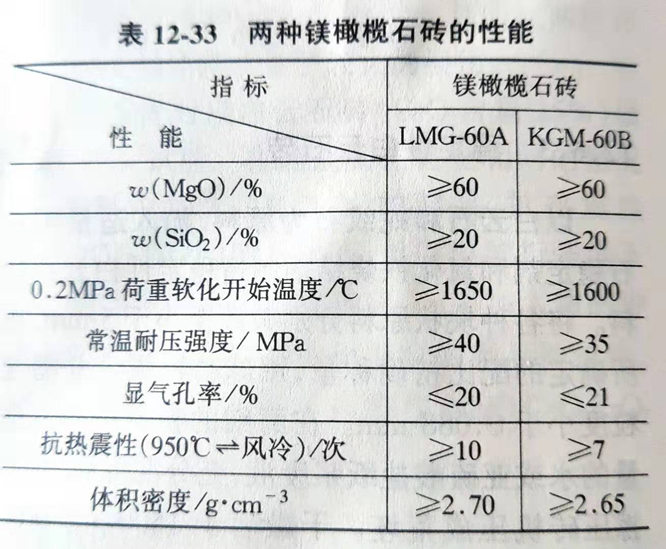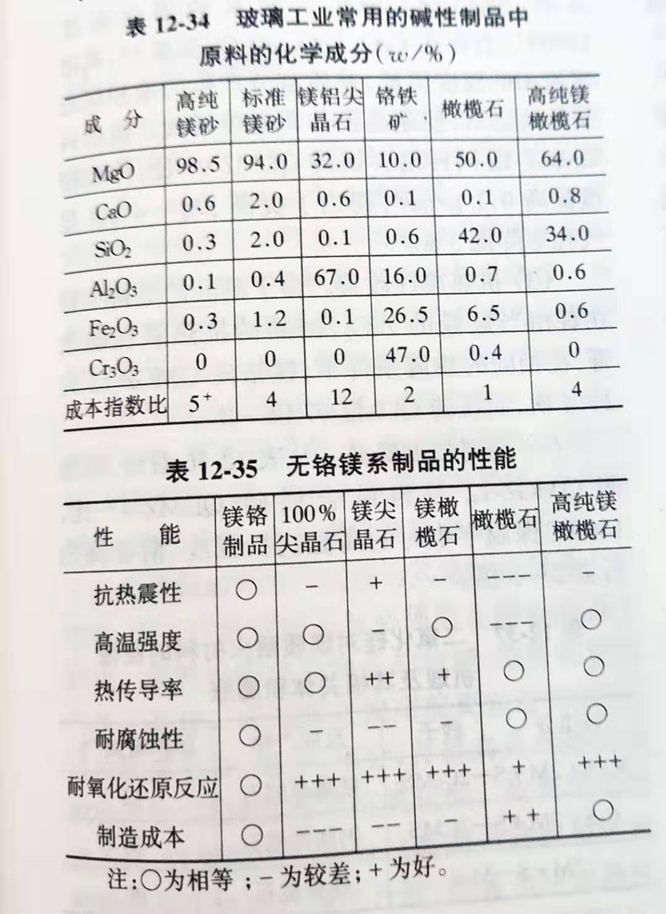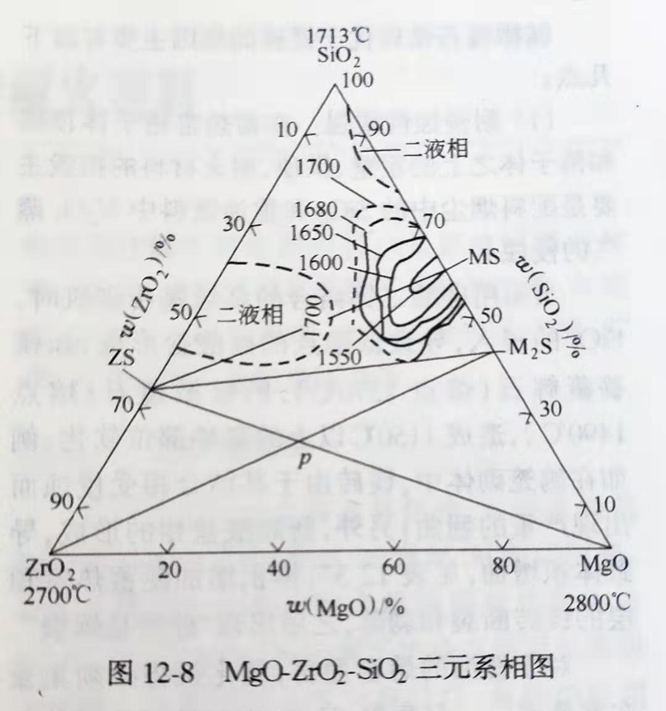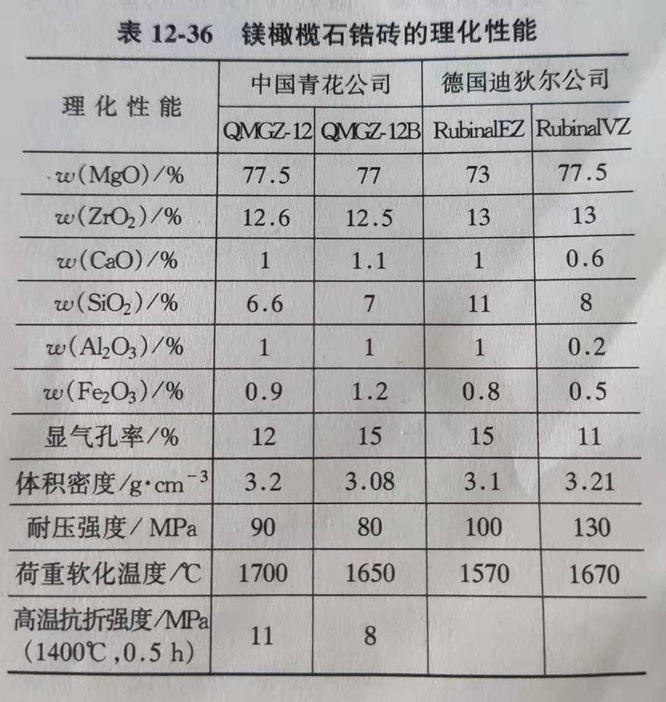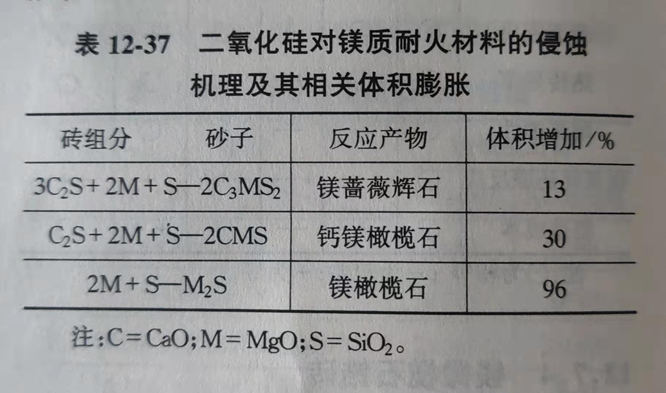Magnesium Brick Products
The refractory products with brucite as the main crystal phase and forsterite as the bonding phase are called magnesia-silicon brick. The production process of magnesia-silicon brick is basically the same as that of ordinary magnesia brick, but the raw material used is magnesia-silica sand. Magnesia-silica sand can be obtained by calcination of high silica magnesite at high temperature. As can be seen from figure 12 - 7, as long as the composition point falls in the MgO-M2S area, the high temperature performance of the product is good. When it is close to the end element of MgO, the high temperature performance is better. When SiO2 is high, magnesite produces more liquid phase in shaft kiln calcination, which is easy to form "tuo" card kiln accident. Magnesite about SiO24% is used to produce magnesium in China. The physical and chemical properties of silica sand are shown in Table 12-31. Using this as raw material, magnesia-silicon brick with good properties can be prepared by firing at 1550 ℃ at 1570 ℃. YB / T416 -1980 specifies the properties of magnesia-silicon cast brick, as shown in Table 12-32. In addition to being used as casting mouth, magnesia-silicon brick can also be used in steel rolling furnace, heating furnace and glass kiln heat storage chamber grid.
Forsterite Brick
With calcined peridotite (which can not be calcined when it is reduced), the product produced from serpentine is called olivine brick. In order to improve its high temperature performance, sintered magnesia is usually added 20% ~ 40%. After proportioning, molding, high temperature firing is magnesia olivine brick. Improve the purity of raw materials and firing temperature, and optimize the properties of the products. Table 12 - 33 lists the properties of two kinds of forsterite brick, which can be used in glass kiln heat storage chamber, ladle and so on.
High-purity Forsterite Brick
Magnesia-silicon brick, olivine brick and magnesia olivine brick made of natural raw materials limit the improvement and application of their properties because of their many impurities. In the development of chromium-free alkaline brick in glass kiln heat storage chamber, high purity magnesia olivine brick has been paid more attention to. High purity magnesia olivine brick is made of magnesia olivine sand as raw material, which has the advantages of high MgO,SiO2 content, less impurities, strong corrosion resistance and good high temperature properties. Although its manufacturing cost is higher than that of olivine containing products, it is much lower than that of products with high spinel content. The chemical composition and cost index of alkaline brick such as high purity magnesia olivine brick for glass kiln are compared in Table 12-34, no chromium.
Magnesium Olivine Zircon Brick
In MgO-ZrO2 multiphase materials, when zircon (ZrSiO4) is used as the source of ZrO2, the phase equilibrium has changed from MgO-ZrO2 binary system to MgO-ZrO2-SiO2 ternary system (Fig. 12 ≤ 8). There is no ternary compound in this ternary system, which is MgO-M2S-ZrO2 coexistence system, and the binding matrix is forsterite and ZrO2.. Germany's DIDIER company called this brick the first generation of magnesia-zirconium brick. From the point of view of phase composition, it seems more accurate to call it brucite forsterite brick or forsterite zircon brick for short.
The ZrO2· SiO2 in the matrix of MgO-ZrO2-SiO2 refractory was first decomposed into ZrO2 and SiO2, which combined with MgO into 2 MgO · SiO2:
2MgO+ZrO2·SiO2→2MgO·SiO2+ZrO2
When MgO refractories are mixed with ZrO2 ·SiO2 as ZrO2 source, the content of SiO2 is also increased with the increase of ZrO2, so they play an important role in different sides of the material. According to the different raw materials and the characteristics of the use environment, the optimal amount of ZrO2 should be selected.
In 1987, DIDIER Company of Germany built magnesia-zirconium brick Rubi-nalEZ in float kiln, transverse flame kiln, arson flame kiln, sodium glass kiln and so on. In 1994, the second generation magnesia-zirconium brick RubinalVZ began to be built on the top of glass kiln lattice. Table 12 -36 lists the properties of magnesia-zirconium bricks.
The main reasons why forsterite zirconium brick is better than magnesia brick are as follows:
The main results are as follows: (1) the corrosion resistance is enhanced. The damage of chamber wall, arch roof and refractory at the top of and above the lattice of heat storage kiln is mainly due to the erosion of SiO2 in soot and V2O5 vapor in heavy oil fuel.
When the high-grade magnesium brick combined with the calcium silicate is used for masonry, the intrusion of the SiO2 causes the formation of low-melting-point silicate, such as the pyroxene (melting point of 1570 DEG C) and the forsterite (melting point of 1490 DEG C), so that the part of the kiln at the temperature of more than 1150 DEG C is softened, for example, in the pigeon cage masonry, In addition, the formation of the new silicate phase leads to an increase in volume, as shown in Table 12-37, and the volume is increased so that the magnesium brick at the top of the heat storage chamber is broken and peeled off, and then a "silicate burst" occurs.
The main reasons why forsterite zirconium brick is better than magnesia brick are as follows:
The main results are as follows: (1) the corrosion resistance is enhanced. The damage of chamber wall, arch roof and refractory at the top of and above the lattice of heat storage kiln is mainly due to the erosion of SiO2 in soot and V2O5 vapor in heavy oil fuel.
When the high-grade magnesium brick combined with the calcium silicate is used for masonry, the intrusion of the SiO2 causes the formation of low-melting-point silicate, such as the pyroxene (melting point of 1570 DEG C) and the forsterite (melting point of 1490 DEG C), so that the part of the kiln at the temperature of more than 1150 DEG C is softened, for example, in the pigeon cage masonry, In addition, the formation of the new silicate phase leads to an increase in volume, as shown in Table 12-37, and the volume is increased so that the magnesium brick at the top of the heat storage chamber is broken and peeled off, and then a "silicate burst" occurs.
